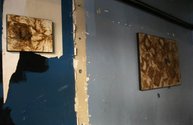John Hurrell – 2 December, 2011
There is also the aspect of fortune telling that vaguely ties in with the overtones of mortality. Experts at tasseomancy might have their own interpretation of some of the detail but from a distance the streaky marks look a little like the ink drawings of Henri Michaux: hundreds of little figures scampering across the page.
Down in the basement of Snake Pit, in the dilapidated remains on an old music club with black walls and peeling paper, local musician and photographer Ivan Mršić presents a collection of ‘paintings’ made from layers of glued-on tissue papers embedded with scattered and encrusted coffee grounds. These have been hoarded from nine years of consuming the beverage regularly, where the waste sludge has been thrown by hand onto the fibrous paper to dry out during storage.
These organic ‘dirty’ works suit the damp, tattered and dissolute space they inhabit here, and in fact are slightly creepy. The umbery peppery dots of the grounds lie on white paper that over time has turned a soft yellowish brown. They are accompanied by tiny discs of mould that have grown on the paper while it was being stored, but which are now fixed via layers of clear matt acrylic. The surface seems like skin than has adipose botches like those you see in forensic photos of decaying corpses. That these images look disease ridden is (to me) part of their - admittedly revolting, but also mysteriously evocative - attraction. Such disturbingly bodily images generate an ambivalent bodily response.
There is also the aspect of fortune telling or fate that vaguely ties in with the overtones of mortality. Experts at tasseomancy might have their own interpretation of some of the detail but from a distance the streaky marks look a little like the ink drawings of Henri Michaux: hundreds of little figures scampering across the page and caught in our Godlike view.
Mršić’s positioning of the tissue paper (often torn) looks in some of the larger works to be composed, but apparently this is not so. However the more appealing paintings succeed because of their sense of order with ‘decisive’ placement. Panels are hung the ‘best’ way up to appear ‘artistic’ so that in itself brings in convincing or compelling arrangements, and perhaps for the viewer, imagined notions of artist’s intention while gluing down the sheets.
Even if these are some sort of Rorschach test where you can read into them what you like, collectively they work well in this scungy site - as if they were ‘birthed’ here and materialised out of these dank walls. If they are put on conventionally tidy and white gallery walls something is definitely lost. My view is that they might survive such a transition if they had super-ornate flambouyant, wide gold frames. An extravagently arabesque buffer enclosing the speckly smears would ease the inside/outside transition formally, and the self-evident inanity of the waste would bring not humour but a democratising of material as equivalents, an unexpected balance.
John Hurrell
Recent Comments
Rising Togale
"A philosophy that is unable to incorporate and elucidate the possibilities of prophesying from coffee grounds cannot be a true ...
John Hurrell
Wittering eh, Owen? Well I would have thought it was an obvious thing to do, to speculate on how to ...
Owen Pratt
I thought tapa,the earth tones and the tissue looks similar to mulberry. As for your wittering last paragraph John about ...








 Two Rooms presents a program of residencies and projects
Two Rooms presents a program of residencies and projects Advertising in this column
Advertising in this column



This Discussion has 6 comments.
Comment
Andrew Paul Wood, 5:19 p.m. 2 December, 2011 #
Shroud of Turin
John Hurrell, 5:35 p.m. 2 December, 2011 #
That's always looked stenciled to me, or some sort of frottage. Do you think it is a chance configuration of mould?
Andrew Paul Wood, 6:03 p.m. 2 December, 2011 #
I think it, like this, is a very deliberate staining cunningly done with organic pigments
Owen Pratt, 7:58 p.m. 5 December, 2011 #
I thought tapa,the earth tones and the tissue looks similar to mulberry.
As for your wittering last paragraph John about how to exhibit these works elsewhere; too much coffee perhaps?
John Hurrell, 8:28 p.m. 5 December, 2011 #
Wittering eh, Owen? Well I would have thought it was an obvious thing to do, to speculate on how to site the work on white walls. Especially as Snake Pit has such facilities upstairs, and initially the artist did try them.
There are occasions admittedly when my writing indicates a caffeine overload, but whether this review provides such an example - I'm not so sure.
Rising Togale, 3:27 a.m. 9 December, 2011 #
"A philosophy that is unable to incorporate and elucidate the possibilities of prophesying from coffee grounds cannot be a true philosophy".
Walter Benjamin
Participate
Register to Participate.
Sign in
Sign in to an existing account.